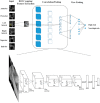Multi-View Convolutional Neural Networks in Rupture Risk Assessment of Small, Unruptured Intracranial Aneurysms
- PMID: 33805171
- PMCID: PMC8064331
- DOI: 10.3390/jpm11040239
Multi-View Convolutional Neural Networks in Rupture Risk Assessment of Small, Unruptured Intracranial Aneurysms
Abstract
Auto-detection of cerebral aneurysms via convolutional neural network (CNN) is being increasingly reported. However, few studies to date have accurately predicted the risk, but not the diagnosis itself. We developed a multi-view CNN for the prediction of rupture risk involving small unruptured intracranial aneurysms (UIAs) based on three-dimensional (3D) digital subtraction angiography (DSA). The performance of a multi-view CNN-ResNet50 in accurately predicting the rupture risk (high vs. non-high) of UIAs in the anterior circulation measuring less than 7 mm in size was compared with various CNN architectures (AlexNet and VGG16), with similar type but different layers (ResNet101 and ResNet152), and single image-based CNN (single-view ResNet50). The sensitivity, specificity, and overall accuracy of risk prediction were estimated and compared according to CNN architecture. The study included 364 UIAs in training and 93 in test datasets. A multi-view CNN-ResNet50 exhibited a sensitivity of 81.82 (66.76-91.29)%, a specificity of 81.63 (67.50-90.76)%, and an overall accuracy of 81.72 (66.98-90.92)% for risk prediction. AlexNet, VGG16, ResNet101, ResNet152, and single-view CNN-ResNet50 showed similar specificity. However, the sensitivity and overall accuracy were decreased (AlexNet, 63.64% and 76.34%; VGG16, 68.18% and 74.19%; ResNet101, 68.18% and 73.12%; ResNet152, 54.55% and 72.04%; and single-view CNN-ResNet50, 50.00% and 64.52%) compared with multi-view CNN-ResNet50. Regarding F1 score, it was the highest in multi-view CNN-ResNet50 (80.90 (67.29-91.81)%). Our study suggests that multi-view CNN-ResNet50 may be feasible to assess the rupture risk in small-sized UIAs.
Keywords: angiography; convolutional neural network; intracranial aneurysm.
Conflict of interest statement
The authors declare no conflict of interest.
Figures


References
Grants and funding
LinkOut - more resources
Full Text Sources
Other Literature Sources

